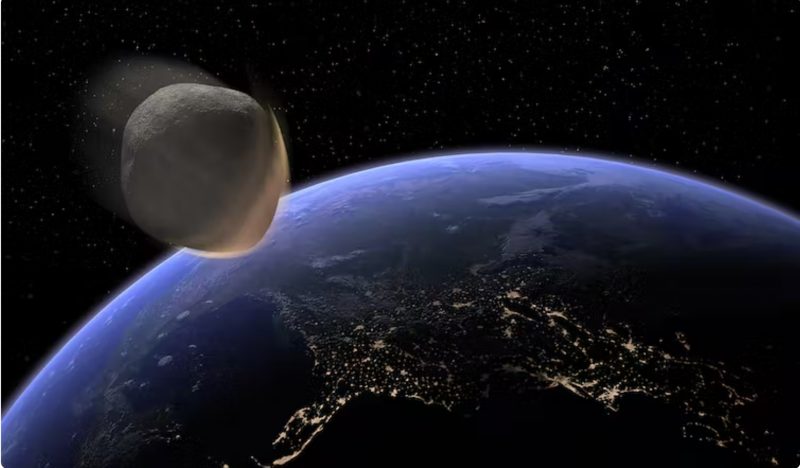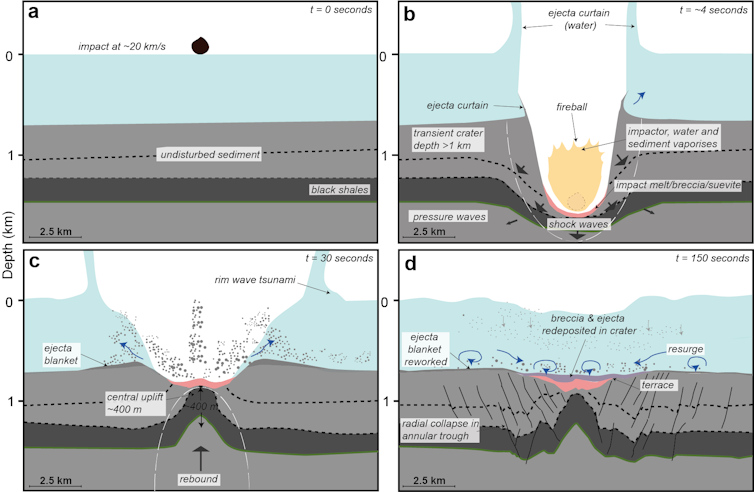
By Uisdean Nicholson, Heriot-Watt University; Sean Gulick, University of Texas at Austin, and Veronica Bray, University of Arizona
The ocean floor is famously less explored than the surface of Mars. And when our team of scientists recently mapped the seabed and ancient sediments beneath, we discovered what looks like an asteroid impact crater.
Intriguingly, the crater, named Nadir after the nearby volcano Nadir Seamount, is of the same age as the Chicxulub impact. This Chicxulub impact occurred when a huge asteroid struck Earth at the end of the Cretaceous period, around 66 million years ago. It wiped out the dinosaurs and many other species.
The peer-reviewed journal Science Advances published the finding on August 17, 2022. It raises the question of whether the crater might be related to Chicxulub in some way. If confirmed, it would also be of huge general scientific interest. It would be one of a very small number of known marine asteroid impacts and provide unique new insights into what happens during such a collision.
The discovery of the crater of a 2nd asteroid
We identified the crater using seismic reflection as part of a wider project to reconstruct the tectonic separation of South America from Africa back in the Cretaceous period. Seismic reflection works in a similar manner to ultrasound data. It sends pressure waves through the ocean and its floor and detects the energy that the features reflect back. This data allows geophysicists and geologists to reconstruct the architecture of the rocks and sediments.
Scrolling through this data at the end of 2020, we came across a highly unusual feature. Among the flat, layered sediments of the Guinea Plateau, west of Africa, was what appeared to be a large crater. It was a little under 10 kilometers (6 miles) wide and several hundred meters deep, buried below several hundred meters of sediment.
Many of its features are consistent with an impact origin. These include the scale of the crater, the ratio of height to width, and the height of the crater rim. The presence of chaotic deposits outside of the crater floor also look like ejecta, material expelled from the crater during a collision.
We did consider other possible processes that could have formed such a crater, such as the collapse of a submarine volcano or a pillar (or diapir) of salt below the seabed. An explosive release of gas from below the surface could also be a cause. But none of these possibilities are consistent with the local geology or the geometry of the crater.

Earthquakes, airblast, fireball and tsunamis
After identifying and characterizing the crater, we built computer models of an impact event. We wanted to see if we could replicate the crater and characterize the asteroid and its impact.
The simulation that best fits the crater shape is for an asteroid 400 meters (1,300 feet) in diameter hitting an ocean that was 800 meters (2,600 feet) deep. The consequences of an impact in the ocean at such water depths are dramatic. It would result in an 800-meter (2,600-foot) thick water column. The asteroid, as well as a substantial volume of sediment, would instantly vaporize, with a large fireball visible hundreds of kilometers away.
Shock waves from the impact would be equivalent to a magnitude 6.5 or 7 earthquake, which would likely trigger underwater landslides around the region. A train of tsunami waves would form.
The air blast from the explosion would be larger than anything heard on Earth in recorded history. The energy released would be approximately a thousand times larger than that from the recent Tonga eruption. It is also possible that the pressure waves in the atmosphere would further amplify the tsunami waves far away from the crater.

Is the 2nd asteroid a Chicxulub relative?
One of the most intriguing aspects of this crater is that it is the same age as the giant Chicxulub event, give or take one million years. They both occurred at the boundary between the Cretaceous and Paleogene periods 66 million years ago. Again, if this really is an impact crater, might there be some relationship between them?
We have three ideas as to their possible relationship. The first is that they might have formed from the break-up of a parent asteroid, with the larger fragment resulting in the Chicxulub event and a smaller fragment (the “little sister”) forming the Nadir crater. If so, the Nadir impact could have compounded the damaging effects of the Chicxulub impact, exacerbating the severity of the mass extinction event.
The break-up event could have formed from an earlier near-collision, when it passed close enough to Earth to experience gravitational forces strong enough to pull it apart. The actual collision could then have occurred on a subsequent orbit.
Although, this pull-apart is exactly what happened to the Shoemaker-Levy 9 comet. Shoemaker-Levy 9 collided with Jupiter back in 1994, and multiple comet fragments collided with the planet over the course of several days.
Part of an impact cluster?
Another possibility is that Nadir was part of a longer lived impact cluster. It would have formed through a collision in the asteroid belt earlier in solar system history. This is known as the little cousin hypothesis.
This collision may have sent a shower of asteroids into the inner solar system. Theese may have collided with the Earth and other inner planets over a more extended time period, perhaps a million years or more. We have a precedent for such an event back in the Ordovician period – over 400 million years ago – when there were numerous impact events in a short period of time.
Or just a coincidence?
Finally, of course, this may just be a coincidence. We do expect a collision of a Nadir-sized asteroid every 700,000 years or so. For now, however, we cannot definitively state that the Nadir crater formed from an asteroid impact. First we have to physically recover samples from the crater floor and identify minerals that can only be formed by extreme shock pressures. To that end, we have recently submitted a proposal to drill the crater through the International Ocean Discovery Program.
As with the main impact crater hypothesis, we can only test the little sister and little cousin hypotheses by accurately dating the crater using these samples, as well as by looking for other candidate craters of a similar age.
Perhaps more importantly, could such an event happen in the near future? It is unlikely, but the size of the asteroid that we model is very similar to the Bennu asteroid currently in near-Earth orbit. Scientists consider this asteroid one of the two most hazardous objects in the solar system, with a one-in-1,750 chance of collision with Earth in the next couple of centuries.![]()
Uisdean Nicholson, Associate Professor of Geoscience, Heriot-Watt University; Sean Gulick, Research Professor of Geoscience, University of Texas at Austin, and Veronica Bray, Research Scientist, Lunar & Planetary Laboratory, University of Arizona
This article is a republish from The Conversation under a Creative Commons license. Read the original article.
Bottom line: Scientists found a crater in the North Atlantic that dates to 66 million years ago, which means it could be a 2nd asteroid related to the dinosaur-killing Chicxulub event.
Source: The Nadir Crater offshore West Africa: A candidate Cretaceous-Paleogene impact structure
Read more: Asteroid dust in Chicxulub crater seals deal on dino extinction
The post Did a 2nd asteroid help kill the dinosaurs? first appeared on EarthSky.
0 Commentaires